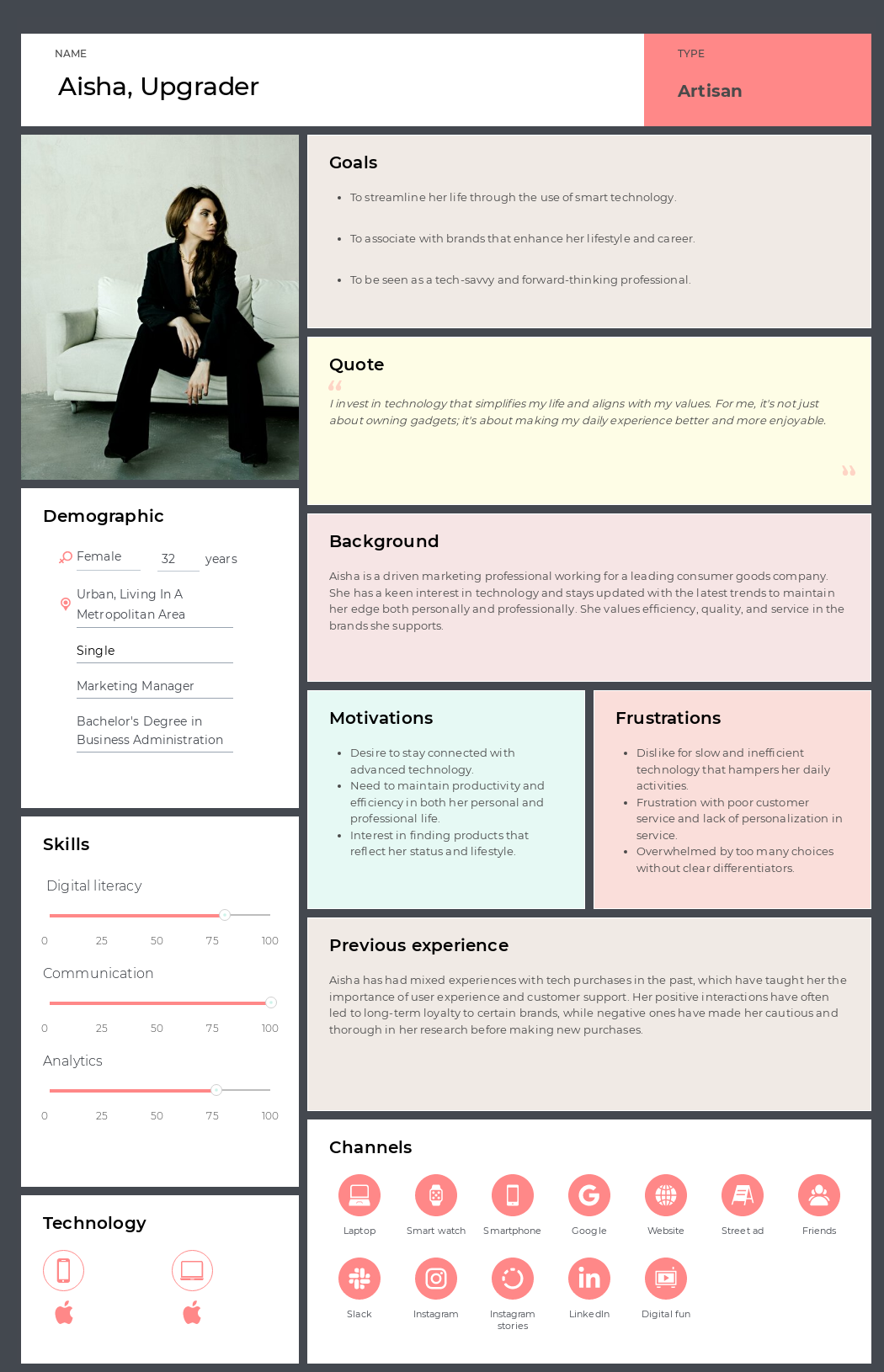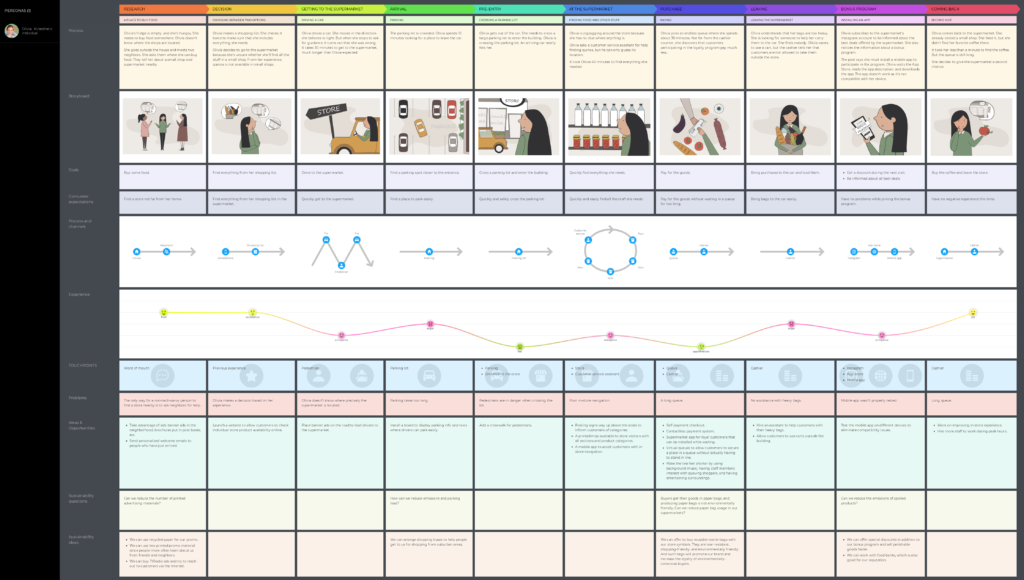Imagine walking into a store looking for a specific gadget. You're ready to buy, but you can't find it anywhere. You seek help, yet the staff seems disorganized and uninterested, unable to tell you whether it’s even in stock. Frustrated, you leave empty-handed, promising never to return. Unfortunately, scenarios like this are all too common, but it doesn't have to be this way.
By crafting a detailed retail customer journey map, businesses can transform a chaotic shopping experience into a smooth, enjoyable journey from start to finish. This powerful tool helps retailers understand every step a customer takes, from initial interest to post-purchase, allowing for strategic enhancements that elevate the shopping experience.
In this article, we delve into the definition of a retail customer journey, explore its various stages, and offer practical examples and retail (aka) shopping customer journey templates to guide you in building your own effective journey map.
Let’s start.
Contents
- 1 What is a retail customer journey?
- 2 Key stages of the retail customer journey
- 3 Loyalty and second purchase
- 4 Why is building a retail customer journey map important?
- 5 How to create a retail customer journey map
- 5.1 1. Define your objectives
- 5.2 2. Gather data
- 5.3 3. Segment your customer base into personas
- 5.4 4. Identify key interactions & channels
- 5.5 5. Map the customer journey
- 5.6 6. Identify emotions and pain points
- 5.7 7. Determine opportunities for improvement
- 5.8 8. Create & prioritize actionable strategies
- 5.9 9. Test and refine
- 5.10 10. Share and educate
- 6 An example of retail customer journey maps
What is a retail customer journey?

The retail customer journey encompasses the complete experience a customer goes through when interacting with a retail brand or business, from initial awareness all the way to post-purchase activities and beyond. Such a journey covers each step a customer takes as they discover, evaluate, purchase, and interact with a retailer’s products and services.
It's easier to understand the retail customer journey through examples. Let's explore three different experiences, all related to retail.
- Maria’s experience: Buying a coffee machine
Maria has always been a coffee lover and often finds herself spending a lot of time at coffee shops. One day, while browsing her favorite lifestyle blog, she read an article about the benefits of brewing coffee at home. Intrigued, Maria visited a popular online retail site to look at coffee machines.
She found a highly-rated model that wasn't just efficient but also aesthetically pleasing. After reading through customer reviews on the website and checking a few video tutorials on its maintenance, she decided to purchase it. A week after using the coffee machine, she received an email from the retailer suggesting complementary products like specialty coffee grounds and descaling solutions, which she gladly purchased. This smooth and informative journey, from recognizing a need to fulfilling it with helpful follow-ups, made Maria a happy customer.
- Tom’s adventure: New running shoes
Tom decided to take up running to improve his fitness. His old sneakers weren’t suitable for running long distances, so he went to a local sports store to explore his options. At the store, a friendly salesperson helped him choose a pair of shoes that would be good for beginners and fit his wide feet comfortably.
The salesperson also suggested a popular running app to track his progress and a local running club to meet fellow enthusiasts. This personalized in-store experience helped Tom find the right shoes and introduced him to resources that could support his new hobby.
- Aisha’s upgrade: Enhancing a smartphone
Aisha had been using her smartphone for over three years, and it was time for an upgrade. Her mobile carrier notified her about an exclusive offer for loyal customers to pre-order the latest smartphone model with a significant discount.
Aisha visited the carrier’s store to explore the new model and was impressed by its advanced features during a hands-on demo by the store staff. She pre-ordered the phone, and when it was released, she received it with a personalized thank-you note and a complimentary phone case as a token of appreciation for her loyalty. This proactive and considerate approach made Aisha feel valued and reinforced her decision to stay with her mobile carrier.
Now, let's zoom in and break down the retail customer journey into stages.
Key stages of the retail customer journey

To capture the nuances of modern retail interactions, it’s beneficial to expand and detail additional stages within the retail customer journey. The number of stages in a journey can vary, depending on your specific case and objectives. However, there are common stages that are crucial, and we'll cover them sometimes using Aisha’s example.
Initial engagement
Before awareness, initial engagement can spark interest. This might involve passive interactions such as seeing a friend wear a product, noticing an ad on social media, or simply passing by the store and being drawn in by its design or a display window. Capturing these moments with retail customer journey mapping can help identify what first pulls customers towards your brand.
For instance, Aisha's journey to upgrading her smartphone started subtly. She first noticed a friend's new phone, admired its design and performance, and then saw an engaging ad on social media from her carrier. A later glance at a store display featuring the phone cemented her interest, leading her from casual observer to potential upgrader.
Awareness
This stage is where potential customers become actively aware of your brand. It could be through targeted advertising, social media presence, or content marketing. Understanding what messages resonate best will refine your strategies for capturing attention effectively. Aisha became actively aware of the new smartphone through a targeted notification from her mobile carrier, an offer tailored specifically for loyal customers. This direct approach, coupled with engaging content on the carrier's social media pages highlighting the phone's advanced features and user testimonials, solidified her interest, making Aisha feel informed and valued.
Research
Following awareness, customers often engage in research to compare your offerings with competitors’. This stage involves more in-depth interactions with your content, visiting your website, reading reviews, and possibly engaging with customer service. Detailed retail customer journey mapping here focuses on making information accessible and easy to navigate.
Following her initial interest, Aisha compared the new smartphone's features and pricing on her carrier's website, read customer reviews, and watched product demos. A visit to the carrier's store provided hands-on experience and direct answers from the staff, giving the information to make an informed decision.
Consideration
Now seriously considering purchase, customers evaluate their options based on price, features, and benefits. Retailers can enhance the customer journey in a retail store by providing clear and concise product information, comparison tools, and well-trained staff to assist in decision-making. Now, seriously considering her options, Aisha is making her own decision.
Validation
Before making a final decision, customers often seek validation of their choice through social proof such as reviews, testimonials, or asking friends and family. Ensuring that positive feedback is visible and easily accessible is crucial in retail customer journey mapping. Before making her final decision, Aisha sought validation by reviewing user testimonials and discussing the upgrade with friends and family.
Purchase
It is the actual transaction stage where the decision is acted upon. Simplifying the purchase process, ensuring multiple payment options, and providing security assurance can greatly enhance the customer experience. At the purchase stage, Aisha acted on her decision to upgrade her smartphone.
She quickly streamlined the process at the carrier's store and pre-ordered the new model. Multiple payment options were available, and the transaction was secure, enhancing her overall experience and ensuring a smooth, hassle-free purchase.
Post-purchase support
Support immediately after purchase is crucial to customer satisfaction. This might include customer service, easy access to warranties, and user guides. Retail customer journey mapping should ensure seamless support to foster positive experiences.
After her purchase, Aisha received excellent post-purchase support, which was crucial to her satisfaction. The carrier provided her with a comprehensive user guide and easy access to warranty information through their website. Additionally, customer service was readily available, offering quick responses to her inquiries and assistance in setting up her new smartphone. This seamless support ensured a positive experience, reinforcing her loyalty to the carrier.
Usage
As customers use the product, their experiences will influence their perceptions of the brand. Providing ongoing support and tips on getting the most out of the product can add value.
As Aisha began using her new smartphone, her experiences significantly influenced her perception of the brand. The carrier ensured she had access to ongoing support, including helpful tips and troubleshooting advice through their app and website. Periodic updates and recommendations on optimizing her smartphone usage also added value, enhancing her overall satisfaction and engagement with the product.
Advocacy
If customers are satisfied with their purchase, they may become brand advocates. Encouraging this through incentives for sharing their experiences on social media or with friends can transform happy customers into active promoters.
The carrier incentivized Aisha to share her positive experiences by offering discounts for future purchases and referral benefits. These incentives motivated her to promote the brand actively, helping to expand its reach through her trusted personal network.
Loyalty and second purchase
The final stages involve cultivating the relationship to build long-term loyalty. Here, the carrier focused on nurturing a long-term relationship with Aisha to foster loyalty. They engaged her with personalized offers, part of a loyalty program tailored to reward continued patronage. Regular communication via newsletters and exclusive updates ensured she stayed connected and felt valued. This strategic engagement solidified her loyalty and set the stage for future repurchases.
Why is building a retail customer journey map important?

A retail customer journey map is essential for any retail business focused on optimizing the customer experience and improving overall business performance. It provides a detailed visual representation of the customer's experience from initial contact through various touchpoints and, ultimately, to post-purchase interactions.
Here’s why building a retail customer experience map and leveraging this tool in your organization is so important:
- Provides deep customer insights. A customer journey map allows retailers to step into their customers' shoes and view their business from the customers’ perspective. It highlights what customers think, feel, and do at each stage of their shopping journey. This insight is crucial for understanding pain points, bottlenecks, and opportunities within the customer experience. By understanding the customer's needs and behaviors at each step, retailers can tailor services and marketing strategies to better meet those needs.
- Enhances customer experience. With a clear view of the customer’s journey, retailers can identify key moments that matter most to customers and focus on improving these critical interactions. For instance, if the journey map shows that customers feel frustrated during checkout, retailers can streamline this step to make it faster and more user-friendly. Improving these key touchpoints enhances the overall customer experience, increasing satisfaction and loyalty.
- Drives personalization. Retail customer journey mapping allows for identifying specific customer segments and their unique paths and preferences. This detailed understanding enables retailers to craft personalized marketing messages, recommend products, and create promotions that resonate with different segments. When done correctly, personalization significantly boosts the effectiveness of marketing efforts, increasing engagement and conversion rates.
- Supports omnichannel consistency. Today’s customers often engage with retailers across multiple channels—online, in-store, via mobile apps, and social media. A comprehensive customer journey map includes all these channels, ensuring the customer experience is consistent and seamless across all touchpoints. This consistency is critical to building customer trust and satisfaction, as they feel confident that they will receive the same level of service regardless of how they interact with the retailer.
- Facilitates data-driven decisions. By mapping the customer journey, retailers can align their strategic decisions with concrete data about customer interactions and satisfaction levels at each stage of the journey. This approach ensures business decisions are grounded in real customer needs and behaviors rather than assumptions. It allows retailers to allocate resources more effectively, invest in areas that will yield the highest return on customer satisfaction, and only spend on areas that significantly impact the customer experience.
- Improves customer retention. By continuously monitoring and optimizing the customer journey, retailers can better retain their customers. A smooth, enjoyable shopping experience increases the likelihood of repeat purchases and turns one-time buyers into loyal customers. Furthermore, by addressing any negative experiences promptly and effectively, retailers can prevent churn and build a strong, loyal customer base.
- Enhances competitive advantage. In a retail environment where many products and prices are similar, the customer experience often becomes the key differentiator. Retailers who excel in creating positive, memorable customer journeys set themselves apart from competitors. This competitive advantage is crucial in attracting and retaining customers in a crowded market.
- Fosters empathy. By visualizing the customer journey, retailers gain a deeper understanding of customers' emotional landscape as they interact with various touchpoints. This empathetic insight allows retailers to more effectively address customer emotions and needs at each stage of their experience. Empathy in business helps resolve conflicts or issues more compassionately and design services and interactions that genuinely resonate with customers, further enhancing their overall experience and satisfaction.
So, a retail consumer journey map is not just a tool for visualizing customer interactions; it's a strategic asset that drives better customer understanding, enhances personalized marketing, ensures consistency across channels, and supports data-driven decisions. These improvements lead to a superior customer experience, higher customer retention, and, ultimately, a stronger competitive position in the market.
How to create a retail customer journey map

Creating a retail customer journey map is a strategic process that helps businesses visualize their customers' path from initial contact through various interactions to final purchase and potentially beyond. Here’s a detailed, step-by-step guide to building an effective map:
1. Define your objectives
Start by clarifying what you hope to achieve with your customer journey map. Are you trying to improve customer satisfaction, increase sales, reduce friction points, or enhance customer loyalty? Your objectives will guide the level of detail and the aspects of the customer experience you choose to analyze.
2. Gather data
Collect data about your customers and their interactions with your business. This process can include:
- Market research to understand customer demographics, preferences, and behaviors.
- Getting customer feedback through surveys, interviews, and reviews.
- Pulling analytical data from your website, social media, and sales platforms to track how customers navigate your retail environment.
- Using sales data to identify buying patterns, popular products, and potential bottlenecks in the purchasing process. This information helps map the steps a customer takes to make a purchase decision.
- Leveraging in-store analytics to track customer movement, in-store behavior, and product interaction. Technologies like heat maps or RFID can provide valuable data on how customers navigate your space.
- Gathering data from loyalty programs to understand customer preferences and repeat purchase behavior. This can provide insights into customer loyalty and retention.
- And so on.
3. Segment your customer base into personas
Identify customer personas representing various segments of your market. Personas should be based on real data and include demographic information, behaviors, goals, and pain points. This helps to tailor the journey map to different needs and expectations. Choose which one(s) you will be mapping.

4. Identify key interactions & channels
Identify all the points of interaction between the customer and your business. That could include online interactions, such as visiting your website or engaging with social media, as well as offline interactions, such as entering your store or speaking with sales staff.
5. Map the customer journey
Create a visual representation of the customer journey for each persona, using the stages we listed above or your own.
6. Identify emotions and pain points
For each stage, consider the customer’s emotional response and potential frustrations or pain points. This activity helps understand the customer’s experience more deeply and identify areas needing improvement.
7. Determine opportunities for improvement
Look for ways to enhance the customer experience at each stage. Consider employing new technologies, improving service protocols, training staff more effectively, or redesigning certain aspects of the shopping environment.
8. Create & prioritize actionable strategies
Based on the opportunities you've identified, develop specific, actionable strategies to improve the customer journey. Assign responsibilities and timelines to ensure these strategies are implemented effectively.
9. Test and refine
Enforce the changes and closely monitor their impact. Use customer feedback and additional data collection to understand the effects of your modifications. Continually refine your customer journey map based on new insights and changing market conditions.
Share the customer journey map and the insights it provides with all levels of your organization, from senior executives to frontline staff. Educate your team about their role in delivering an exceptional customer experience, ensuring everyone understands and embraces their responsibilities.
Creating a customer journey map requires effort and ongoing attention, but it’s a powerful tool that can dramatically improve how customers perceive and interact with your business.
An example of retail customer journey maps
When you understand why and how to build retail customer journey maps, you might create a retail food customer journey map, a journey of a woman going grocery shopping in a new neighborhood:
Feel free to use this template as a source of inspiration and tweak them to fit your specific cases. You'll do great!






